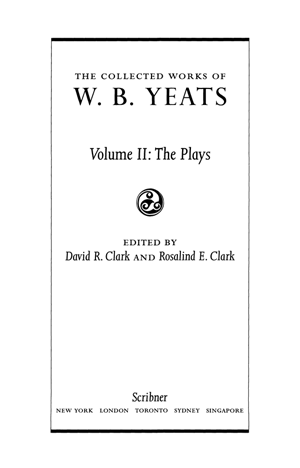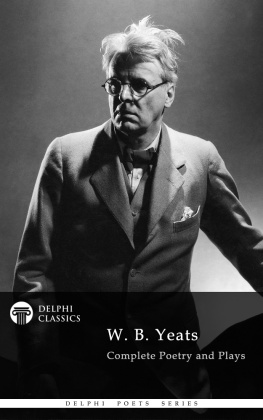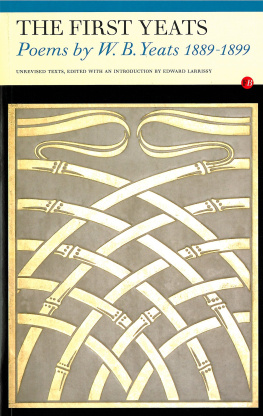The Plays

THE COLLECTED WORKS OF W. B. YEATS
VOLUME II
THE COLLECTED WORKS OF W. B. YEATS
Richard J. Finneran and George Mills Harper, General Editors
VOLUME I THE POEMS
ed. Richard J. Finneran
VOLUME II THE PLAYS
ed. David R. Clark and Rosalind E. Clark
VOLUME III AUTOBIOGRAPHIES
ed. William H. ODonnell and Douglas Archibald
VOLUME IV EARLY ESSAYS
ed. Warwick Gould and Deirdre Toomey
VOLUME V LATER ESSAYS
ed. William H. ODonnell
VOLUME VI PREFACES AND INTRODUCTIONS
ed. William H. ODonnell
VOLUME VII LETTERS TO THE NEW ISLAND
ed. George Bornstein and Hugh Witemeyer
VOLUME VIII THE IRISH DRAMATIC MOVEMENT
ed. Mary FitzGerald
VOLUME IX EARLY ARTICLES AND REVIEWS
ed. John P. Frayne
VOLUME X LATER ARTICLES AND REVIEWS
ed. Colton Johnson
VOLUME XI MYTHOLOGIES
ed. Warwick Gould, Michael Sidnell, and Deirdre Toomey
VOLUME XII JOHN SHERMAN AND DHOYA
ed. Richard J. Finneran
VOLUME XIII A VISION (1925)
ed. Connie K. Hood and Walter Kelly Hood
VOLUME XIV A VISION (1937)
ed. Connie K. Hood and Walter Kelly Hood

Atheneum Books for Young Readers
An imprint of Simon & Schuster Childrens Publishing Division
1230 Avenue of the Americas, New York, New York 10020
www.SimonandSchuster.com
This book is a work of fiction. Any references to historical events, real people, or real locales are used fictitiously. Other names, characters, places, and incidents are products of the authors imagination, and any resemblance to actual events or locales or persons, living or dead, is entirely coincidental.

SCRIBNER
1230 Avenue of the Americas
New York, NY 10020
This book is a work of fiction. Names, characters, places, and incidents either are products of the authors imagination or are used fictitiously. Any resemblance to actual events or locales or persons, living or dead, is entirely coincidental.
Copyright 2001 by Anne Yeats
Notes and preparatory material copyright 2001 by David R. Clark and Rosalind E. Clark
All rights reserved, including the right of reproduction in whole or in part in any form.
Scribner and design are registered trademarks of Macmillan Library Reference USA, Inc., used under license by Simon and Schuster, the publisher of this work.
For information regarding special discounts for bulk purchases, please contact Simon & Schuster Special Sales at 1-800-456-6798 or business@simonandschuster.com
Set in Sabon
Manufactured in the United States of America
1 3 5 7 9 10 8 6 4 2
Library of Congress Cataloging-in-Publication Data is available.
ISBN 0-684-85723-5
ISBN-13:978-0-6848-5723-7
eISBN-13:978-1-4391-0576-4
Due to length, all of the copyright information could not fit on this page, thus page 957 shall be considered an extention of this copyright page.
CONTENTS
PREFACE
Yeatss great achievement in lyric poetry should not be allowed to overshadow his achievement as a dramatist. Eric Bentley has called him the only considerable verse playwright in English for several hundred years.
These tributes praise Yeats as a verse dramatist, but Samuel Beckett made no such limitation. Asked to honor George Bernard Shaw, he declared, I wouldnt suggest that G. B. S. is not a great playwright, whatever that is when its at home. What I would do is give the whole unupsettable apple-cart for a sup of the Hawks Well, or the Saints, or a whiff of Juno, to go no further.
For Yeats is also a supreme modern dramatist for some of those who value the dramatic use of stage space equally with language, value the pre-verbal, the pre-literary as playwright Thomas Kilroy puts it. [M]ost readers of Yeatss plays come equipped with the experience of the poems, the prose, the Vision. And it is not enough. For Yeats is to be found at one of the centers of the modern dramatic tradition. It is a center that subscribes to the integrity, the wholeness, the autonomy of stage practice, one which undermines the idea of humanist imitation which had long dominated the European theatre.
From the beginning Yeats regarded himself as a dramatic poet. Poetry, for him as a youth, meant plays. I had begun to write poetry in imitation of Shelley and of Edmund Spenser, play after playfor my father exalted dramatic poetry above all other kindsand I invented fantastic and incoherent plots.
Yeats conceived his poems and plays as part of one oeuvre. For many years the principal volume which represented the work of the early Yeats was Poems (London: T. Fisher Unwin), issued twelve times between 1895 and 1924, and giving prominence to the plays The Countess Cathleen and The Land of Hearts Desire as well as to the long narrative poem The Wanderings of Oisin.
In a 1916 note on the first of his middle-period dance plays, he wrote: I need a theatre; I believe myself to be a dramatist; I desire to show events and not merely tell of them; and two of my best friends were won for me by my plays, and I seem to myself most alive at the moment when a room full of people share the one lofty emotion. My blunder has been that I did not discover in my youth that my theatre must be the ancient theatre that can be made by unrolling a carpet or marking out a place with a stick, or setting a screen against the wall.
While Yeats is listed as the single author of the plays, he would have insisted that we acknowledge the collaboration of Lady Gregory in those containing folk dialect, such as Cathleen ni Houlihan, The Pot of Broth, and The Unicorn from the Stars. Most of the dialogue of such plays must be hers, even when the conception was his. Yet these plays were published under Yeatss name alone, either with her consent or at her insistence, Yeats acknowledging his debt to her, inadequately it now seems, in notes and dedications. But each friend, in that milieu, sought and accepted help from the other at need.
In the present volume, the order of plays in the familiar Collected Plays is abandoned and the order of the unpublished collected editions is preferred. The Collected Plays of W. B. Yeats (London, 1934, and New York, 1935) was the fullest collection of plays published in Yeatss lifetime (1865-1939). In that book Yeats chose to place together the plays of the Ulster CycleDeirdre and the four plays about the Irish hero Cuchulainand to arrange them in the order of the events of Cuchulains life. Yeats did this at the cost of violating the order in which the plays were written and the order in which their very different dramatic forms evolved. After Yeatss death, The Collected Plays of W. B. Yeats (London, 1952, and New York, 1953) brought the first collection up to date with five plays first published between 1934 and 1939. No change was made from the order of the 1934 volume, the five new plays being simply added at the end, with The Death of Cuchulain appropriately concluding the volume rather than being placed back with the earlier plays of the Cuchulain cycle.
Unlike the Collected Plays, two collected editions which Yeats planned but which were never published maintained a roughly chronological order and did not gather together the plays of the Cuchulain cycle. Macmillan, London, was at various times preparing a De Luxe Edition of all Yeatss work, called, after Yeatss death, the Coole Edition. Yeats provided Macmillan copy for six of the seven volumes
Next page








